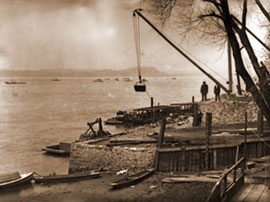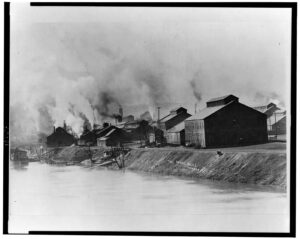
Featured image: Angelo Mamone – Moraine State Park
Here it is: all organisms depend on their environments for energy and the materials needed to sustain life: clean air, potable water, nutritious food, and safe places to live.
For most of human history, increases in longevity were due to improved access to these necessities. Advances in agriculture, sanitation, water treatment, and hygiene have had a far greater impact on human health than medical technology.
With roughly half the temperate and tropical forests cut down, half the ice-free, desert-free terrestrial landscape converted to croplands or pasture, and more than 800,000 dams impeding the flow of water through more than 60% of the world’s rivers, alterations to our planet’s land use and land cover represent some of the most pervasive changes humanity has made to Earth’s natural systems.
We need to understand how human impacts on natural environments affect public health. This understanding can change and inform decision-making in land-use planning, environmental conservation, and public health policy.1
How better to appreciate our land’s vital role in public health than to examine it in context – historically and in our future goals? We think of our forests and natural areas as recreational, but without taking the long view – we may “not see the forest for the trees.”
Pennsylvania’s first conservationist, William Penn, set these conditions on those who would settle in his province: “in clearing the ground, care be taken to leave one acre of trees for every five acres cleared.” Later, Philadelphia physician Benjamin Rush, (a signer of the Declaration of Independence) wrote the first case report on dengue fever and initiated public works associated with draining and rerouting Dock Creek, eliminating mosquito breeding grounds, which greatly decreased typhus, typhoid, and cholera outbreaks. Improved public health through environmental advocacy is still relevant, 300+ years later.
Champions of the Conservation and Public Health Connection
The connection between public health and environmental advocacy got a foothold in the 1880s when MIT graduate and chemist Ellen Swallow Richards focused her interests on issues of sanitation, particularly air and water quality. She performed a series of water tests of local waters, which, at the time, served as drinking water for their immediate populations.
Here in Pennsylvania, in the early 1900s, Mira Lloyd Dock became a true champion of public health through environmental advocacy. Witty and charming, Dock embarked on her “City Beautiful” activities in Harrisburg and through her writings and lectures she developed a large acquaintance among landscape architects, conservationists, and foresters, including Gifford Pinchot. She firmly believed that parks, recreational opportunities, clean streets, and clean inhabitants were compatible with a city’s economic success.
Dock’s closest ally in urban conservation was J. Horace McFarland (for more on McFarland, see PPFF Summer 2013 newsletter). Together, they contrived a plan to accomplish the formidable task of transforming Pennsylvania’s state capital from a dingy, filthy railroad/industrial town into a model city. The steep bank of the Susquehanna River near downtown Harrisburg had saved it from use as a railroad bed or steel mill construction but was instead fouled by raw sewage, garbage, and coal ashes. In April 1901, the Harrisburg Telegraph ran an article stressing her theme of beautification and recreation, which called for parks, pure water, paved streets, a city hall, a covered sewer interceptor, and green space along the river. Within fifteen years all of these improvements, and more were in place. Park acreage increased from 46 in 1902 to 958 in 1915.
A Wake-up Call – The Johnstown flood
Easily one of the most dramatic cause-and-effect scenarios in Pennsylvania between public health and conservation is the Johnstown flood. Johnstown was a booming steel center with a population of 30,000 by 1889. It was built on the floodplain at the confluence of the Little Conemaugh and Stoneycreek rivers.
Increased runoff from the hills due to deforestation, appropriation of riverbanks to accommodate more building space, and poor dam maintenance completed the disaster trifecta. On May 30, 1889, heavy rains broke the dam, unleashing 20 million tons of water at the same velocity the Niagara River goes over the falls. Farmers below the dam said that the wave was “a turbulent wall of water, filling the entire valley.”

Johnstown Flood – view near Main Street.
In the aftermath, disease washed over Johnstown as hard as the water, with typhoid adding 40 more casualties to the initial death toll of 2,209 from the flood. The final tally of the damage came to $17 million and the clean-up took years to accomplish. Bodies were still being found for months, in some cases years, after the flood.
In response to issues such as deforestation and land use, Governor Beaver (1887-91), promoted conservation measures for forests and waterways. In 1897, PA’s first State Forest Reservation Commission was formed with one of its specific goals, “to protect sources of water supply on the headwaters of the Delaware, Susquehanna, and Ohio rivers.” Mira Dock was appointed to the Commission in 1901 (along with Joseph Rothrock, considered the “father” of PA forestry), the first woman to be appointed to a government post in the Commonwealth. In 1910, she introduced a resolution to instruct the foresters and forest rangers to see to it that all brooks and springs within the State Forest Reserves be kept free from garbage and refuse.

The Susquehanna riverfront before Mira Lloyd Dock’s “City Beautiful” efforts.
Photo credit: PA Capitol Preservation
Committee
PA’s Role in the Clean Air Act
In October 1948, Donora, Pennsylvania was enveloped in a lethal haze. Over five days, nearly half of the town’s 14,000 residents experienced severe respiratory and cardiovascular problems. It was difficult to breathe. Twenty people were asphyxiated and over 7,000 were hospitalized. Disturbing photos show Donora’s streets hidden under a thick blanket of gray smog. A warm air pocket had passed high above the town, trapping cooler air below and sealing in pollutants.

The Wire Mill at Donora, PA.
Steel and zinc smelters had long plagued the town with dirty air, but the air pocket left pollutants with no escape route. The situation in Donora was extreme, but it reflected a trend. Air pollution had become a harsh consequence of industrial growth across the country and the world.
Crises like Donora’s were widely publicized; people took notice and began to act.
Scientists started investigating the link between air pollution and health. States began passing legislation to reduce air pollution. In 1970, a milestone year, Congress passed the Clean Air Act Amendments which led to the establishment of the nation’s air quality standards.
Presently, PA’s Bureau of Air Quality is responsible for safeguarding the health of Pennsylvanians by achieving the goals of the federal Clean Air Act and the Pennsylvania Air Pollution Control Act. The bureau develops air quality regulations and conducts meteorological tracking and air quality modeling studies and reviews.
Clean Water Act
For much of our country’s past, our water resources were not protected but were instead exploited. Environmental laws did not provide the level of protection needed and often allowed pollution and environmental damage to continue. For example, despite the widespread knowledge of the harm inflicted by coal mining operations, mining companies in Pennsylvania were often exempted from regulations intended to protect waterways. As a result, decades of under-regulated mining resulted in thousands of miles of Pennsylvania streams being degraded or dead from the effects of acid mine drainage.
As the state felt the impact of unregulated discharge into waterways, a series of legislative initiatives occurred— addressing not just coal, but other forms of discharge, in an attempt to reduce the effects of pollution. Notable Pennsylvania milestones include:
1897 – State Forest System created
1898 – First state forest lands were purchased to protect watersheds
1909 – A law is passed forbidding emptying any waste into any waters of the Commonwealth that could jeopardize fish populations.
1937 – Passage of Clean Stream Law, amended in 1945
1945 – Surface Mining Conservation and Reclamation Act is passed and is considered to be the first comprehensive attempt to prevent pollution from surface coal mining By the 1960s, the harm caused by exploitive uses of waterways began to be recognized across the country and brought about a shift in the way these resources would be regarded.
1972 – The Clean Water Act established a national water quality program.
1961-1970 Regulations of surface mining began as hundreds of miles of streams and thousands of acres of land had been disturbed or ruined. The Delaware River Basin Commission (DRBC) adopted the most comprehensive water quality standards of any interstate river basin in the nation.
1970 – Clean Stream Law rewritten
1971 – Surface Mining Conservation and Reclamation Act 147
1977 – Clean Water Act becomes law
The Conservation Heritage Project – The Commonwealth of Pennsylvania has a remarkable history of conservation dating at least to the late 19th century when industrialization rapidly took hold and when environmental resources were impacted and, in many cases, depleted by economic growth. Conservation efforts are also apparent in the efforts of people who worked to conserve and protect environmental resources. Pennsylvania’s Conservation Heritage Project combines academic research, interviews and technology, to create a comprehensive archive of this important story.
Looking Forward
The evolving dialogue over the use and preservation of resources reflects the links between economics and ecology that once troubled wildlife biologist Aldo Leopold. He conceived of ecology as a ‘round river’ whereby the movement of moisture from land to air and into water is a metaphor standing for how rivers, forests, wildlife, and humans all shared the same sources of well-being. The health of the ecosystem he believed was embedded in the beauty and functional integrity of places and must be restored and maintained. His model reminds us that whatever we do to the surroundings we inhabit, we ultimately do to one another. When debating preservation and use of natural resources, the ‘round river’ image reminds us of a deeper reality. We all live on the same ‘round river.’
Improved public health through environmental conservation is still relevant 300+ years later.
1 The Hastings Center (an independent, nonpartisan, and nonprofit bioethics research institute founded in 1969. The Center’s mission is to address fundamental ethical issues in the areas of health, medicine, and the environment as they affect individuals, communities, and societies.)
###
About the Pennsylvania Parks and Forests Foundation
Founded in 1999, the Pennsylvania Parks and Forests Foundation supports 124 state parks and 2.2 million acres of forest by coordinating volunteers, activities, and donations through its 47 chapters. The mission of the foundation is to inspire stewardship of Pennsylvania’s state parks and forests. More at https://paparksandforests.org/.
Follow us on social media:
Facebook: @PennsylvaniaParksAndForestsFoundation
Twitter: @PaPFF
Instagram: @paparksandforests
LinkedIn: Pennsylvania Parks and Forests Foundation






